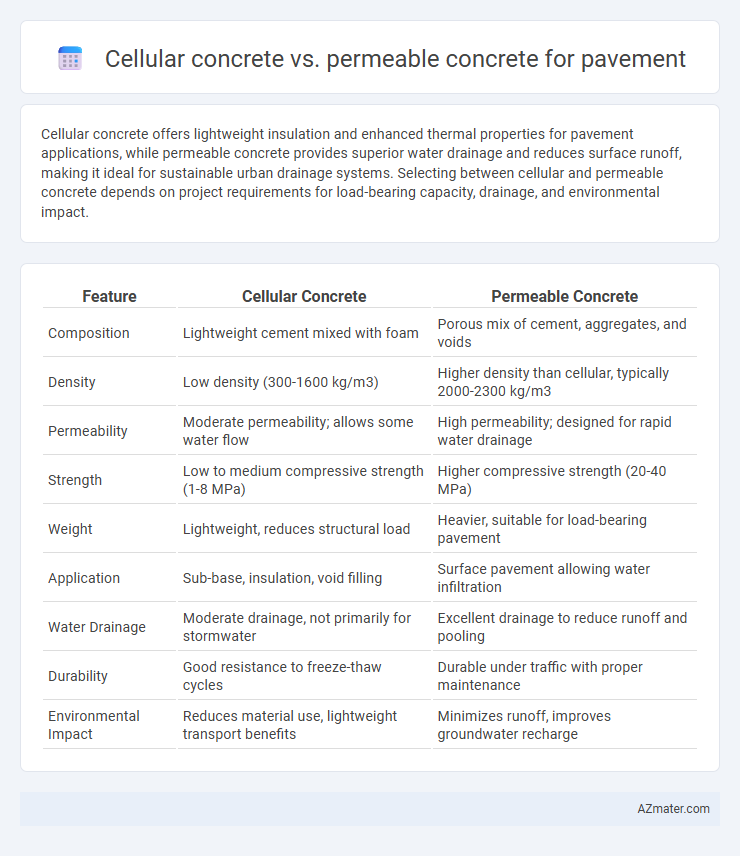Cellular concrete offers lightweight insulation and enhanced thermal properties for pavement applications, while permeable concrete provides superior water drainage and reduces surface runoff, making it ideal for sustainable urban drainage systems. Selecting between cellular and permeable concrete depends on project requirements for load-bearing capacity, drainage, and environmental impact.
Table of Comparison
| Feature | Cellular Concrete | Permeable Concrete |
|---|---|---|
| Composition | Lightweight cement mixed with foam | Porous mix of cement, aggregates, and voids |
| Density | Low density (300-1600 kg/m3) | Higher density than cellular, typically 2000-2300 kg/m3 |
| Permeability | Moderate permeability; allows some water flow | High permeability; designed for rapid water drainage |
| Strength | Low to medium compressive strength (1-8 MPa) | Higher compressive strength (20-40 MPa) |
| Weight | Lightweight, reduces structural load | Heavier, suitable for load-bearing pavement |
| Application | Sub-base, insulation, void filling | Surface pavement allowing water infiltration |
| Water Drainage | Moderate drainage, not primarily for stormwater | Excellent drainage to reduce runoff and pooling |
| Durability | Good resistance to freeze-thaw cycles | Durable under traffic with proper maintenance |
| Environmental Impact | Reduces material use, lightweight transport benefits | Minimizes runoff, improves groundwater recharge |
Overview of Cellular Concrete and Permeable Concrete
Cellular concrete is a lightweight, foam-filled material known for its low density and excellent thermal insulation properties, making it ideal for sub-base pavement applications where reduced load is essential. Permeable concrete features interconnected voids that allow water to pass through, promoting superior drainage and reducing surface runoff in pavements exposed to heavy rainfall or urban flooding. Both materials offer unique advantages for specific pavement needs, with cellular concrete prioritizing weight reduction and permeability concrete emphasizing water management.
Material Composition and Structure
Cellular concrete is composed of cement, water, and pre-formed foam, resulting in a lightweight, aerated structure with numerous air voids that reduce density and enhance insulation properties. Permeable concrete consists of a mixture of cement, coarse aggregates, and minimal fine aggregates, creating a porous matrix designed to allow water infiltration through interconnected voids. The composition and pore structure in cellular concrete prioritize light weight and insulation, while permeable concrete focuses on permeability and load-bearing capacity for pavement applications.
Key Differences in Installation Methods
Cellular concrete requires controlled mixing of cement, water, and a foaming agent to create a lightweight, aerated mixture that is poured and leveled on-site, offering quick curing and minimal compaction. Permeable concrete involves a carefully designed mixture with little to no fine aggregates, requiring consistent compaction with vibratory rollers or plate compactors to maintain pore structure for water infiltration. The installation of cellular concrete emphasizes volume and flow, while permeable concrete demands precise compaction techniques to ensure permeability and structural integrity.
Comparative Strength and Durability
Cellular concrete exhibits lower compressive strength ranging from 1.2 to 15 MPa compared to permeable concrete, which typically achieves 20 to 35 MPa, making permeable concrete more suitable for high-traffic pavement applications. Durability of permeable concrete is enhanced by its resistance to freeze-thaw cycles and reduced clogging potential, whereas cellular concrete's lightweight, porous structure leads to faster degradation under heavy loads and water exposure. Therefore, permeable concrete offers superior strength and long-term durability benefits for sustainable pavement solutions.
Water Permeability and Drainage Capabilities
Cellular concrete features closed-cell structures that limit water permeability, making it less effective for drainage in pavement applications. Permeable concrete contains interconnected voids designed to allow rapid water infiltration, significantly improving surface drainage and reducing runoff. Effective stormwater management and groundwater recharge rely heavily on the superior permeability and drainage capabilities of permeable concrete compared to cellular concrete.
Thermal Insulation and Energy Efficiency
Cellular concrete offers superior thermal insulation properties compared to permeable concrete due to its closed-cell structure, which reduces heat transfer and helps maintain stable surface temperatures in pavement applications. This enhanced insulation capability lowers energy consumption for adjacent buildings and urban heat island mitigation, contributing to overall energy efficiency. Permeable concrete, while beneficial for water drainage, has a denser matrix that provides less thermal resistance, making cellular concrete the preferred choice for energy-efficient pavement designs.
Environmental Impact and Sustainability
Cellular concrete offers enhanced thermal insulation and reduced material usage, leading to lower carbon emissions during production compared to traditional concrete. Permeable concrete significantly improves stormwater management by allowing water infiltration, reducing runoff and minimizing urban flooding risks. Both materials contribute to sustainable pavement solutions, with cellular concrete emphasizing resource efficiency and permeable concrete enhancing groundwater recharge and pollution control.
Cost Analysis and Economic Considerations
Cellular concrete typically has lower material costs due to its lightweight composition and reduced cement usage compared to permeable concrete, making it more cost-effective for large-scale pavement projects. Permeable concrete requires higher initial investment because of specialized aggregate selection and installation techniques that ensure adequate water infiltration and structural integrity. Economic considerations must also factor in long-term maintenance expenses, where permeable concrete may incur higher costs due to clogging prevention and repairs, whereas cellular concrete offers savings from easier installation and lower labor intensity.
Best Applications for Urban Pavement Projects
Cellular concrete is ideal for urban pavement projects requiring lightweight, insulating fill solutions that reduce load on underlying soil and improve drainage beneath slabs. Permeable concrete excels in applications focused on stormwater management, allowing water to infiltrate and reducing runoff in urban areas prone to flooding. Both materials enhance urban infrastructure sustainability, with cellular concrete favored for structural void filling and permeable concrete chosen for porous pavement surfaces that support green infrastructure initiatives.
Choosing the Right Concrete: Factors to Consider
Selecting the right concrete for pavement hinges on factors such as load-bearing capacity, drainage needs, and environmental impact. Cellular concrete offers lightweight, insulating properties and reduces structural load, making it suitable for sub-base layers, while permeable concrete excels at managing stormwater runoff and minimizing surface water accumulation. Evaluating site-specific conditions, traffic demands, and sustainability goals ensures optimal pavement performance and longevity.

Infographic: Cellular concrete vs Permeable concrete for Pavement
 azmater.com
azmater.com